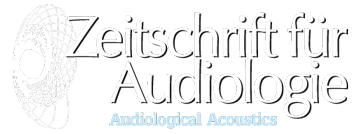Otoacoustic emissions stimulated by bone conduction – a review
Otoakustische Emissionen stimuliert über
Knochenleitung – eine Übersicht
Makram Zebian 1, Florian Kandzia 2, Thomas Janssen 3, Johannes Hensel 1, Thomas Fedtke 1
1 Physikalisch-Technische Bundesanstalt (PTB), Braunschweig, Germany
2 PATH medical GmbH, Germering, Germany
3 Hals-Nasen-Ohrenklinik, Technische Universität München, Munich, Germany
Abstract | Otoacoustic emissions (OAEs) are commonly evoked by air conduction (AC) through one or more miniature loudspeakers embedded in an OAE probe. To date, only a few studies have dealt with the bone-conduction (BC) stimulation of OAEs. The aim of this review is to give a summary on the main literature concerning this topic and to outline the advantages as well as the limitations of this alternative stimulation of OAEs. Generally, both distortion product otoacoustic emissions (DPOAEs) and transient evoked otoacoustic emissions (TEOAEs) can be stimulated by BC, showing properties similar to AC-OAEs. One practical advantage of BC is that miniaturized microphone probes (without the need of the probe loudspeakers) can be constructed, which is be neficial for small ear canals, e.g., in newborns. Since the BC stimulus reaches both cochleae simultaneously, binaural BC-OAE measurements are also possible. Clinically, BC-OAEs are expected to be less sensitive than AC-OAEs to conductive hearing loss, since the BC stimulus reaches the cochlea unimpeded by a possible middle-ear disorder and only the reverse OAE transmission is affected by the latter. Hence, the presence of BC-OAEs amid a lack of AC-OAEs signalizes a middle-ear dysfunction. Concerning the calibration of the stimuli, BC provides some advantages over AC, especially for DPOAEs. BC stimulation avoids errors caused (i) by ear-canal standing waves, since the BC stimuli bypass the ear canal, and (ii) by evanescent waves, since the bone vibrators (e.g., on the forehead or behind the ear) are spatially separated from the probe microphone (in the ear). In the case of DPOAEs, a concurrent AC/BC stimulation can also be achieved by presenting one tone via AC and the other via BC. When using this combined stimulation, one may benefit from swapping the acoustic signal paths and repeating the DPOAEs measurement in the same in-situ position of the probe to validate the stimulus calibration at the cochlea. Whereas further investigations are required to establish BC-OAEs as a standardized objective tool in the clinical diagnosis, BC stimulation already provides an alternative approach, with the stimulitaking a direct path towards the cochlea. Hence,it may be employed complementarily to AC stimulation, opening up various possibilities from the verification of ear-canal probe calibration to the potential differential diagnosis of conductive hearing disorders by means of OAEs.
Keywords: otoacoustic emissions, air conduction, bone conduction, calibration
Zusammenfassung | Otoakustische Emissionen (OAE) werden üblicherweise mit einem oder mehreren in eine OAE-Sonde eingebauten Miniaturlautsprechern über Luftleitung (air conduction: AC) evoziert. Bislang haben sich nur wenige Studien der OAE-Stimulation über Knochenleitung (bone conduction: BC) gewidmet. Ziel dieses Übersichtsartikels ist es, eine Zusammenfassung der aktuell in der Literatur vorhandenen Studien über diese Stimulationsart zu geben und auf deren Vorteile und Grenzen einzugehen. Prinzipiell zeigen sowohl die distorsionsproduzierten otoakustischen Emissionen (DPOAE) als auch die transient evozierten otoakustischen Emissionen (TEOAE) ähnliche Eigenschaften wie die AC-OAE. Die BC-Stimulation erlaubt den Einsatz miniaturisierter Mikrofonsonden (ohne Lautsprecher), was insbesondere für kleinere Gehörgänge, beispielsweise von Neugeborenen, vorteilhaft ist. Klinisch ist es durchaus zu erwarten, dass diese Stimulation weniger von Schallleitungsstörungen beeinflusst wird, weil die BC-Stimuli die Cochlea von Mittelohrproblemen unbeeinflusst erreichen und nur die rückwärts laufende OAE von Letzterem betroffen ist. Sind beispielsweise BC-OAE vorhanden, aber keine AC-OAE, deutet dies auf eine Mittelohrproblematik hin. Die BC-Stimulation hat einige Vorteile gegenüber der AC-Stimulation, insbesondere im Hinblick auf die Stimuluskalibrierung für DPOAE. Die BC-Stimulation (i) umgeht die aufgrund stehender Wellen im Gehörgang entstehenden Kalibrierfehler, und (ii) eliminiert wegen der örtlichen Trennung der Knochenleitungshörer (z. B. hinter dem Ohr oder auf der Stirn) und des OAE-Sondenmikrofons (im Ohr) die Nahfeldeffekte. Für DPOAE ist auch eine gleichzeitige Stimulation möglich, bei der jeweils ein Ton über AC und der andere über BC dargeboten werden. Diese kombinierte AC/BC-Stimulation erlaubt das Vertauschen der akustischen Übertragungswege und eine Wiederholung der DPOAE-Messung in derselben In-situ-Position der Sonde. Diese Eigenschaft kann zur Validierung der Stimuluskalibrierung am Innenohr verwendet werden. Während weiterführende Studien notwendig sind, um die BC-OAE als eine standardisierte objektive Methode in der klinischen Diagnostik zu etablieren, stellt diese Stimulationsart bereits jetzt eine Alternative dar, bei der die Stimuli über einen direkten Weg zur Cochlea gelangen. Die BC-Stimulation könnte komplementär zur AC-Stimulation eingesetzt werden und eröffnet vielfältige Möglichkeiten, von der Verifikation der Gehörgangssondenkalibrierung bis hin zur Differentialdiagnose von Schallleitungsstörungen mittels OAE.
Schlüsselwörter: Otoakustische Emissionen, Luftleitung, Knochenleitung, Kalibrierung
